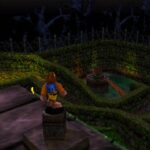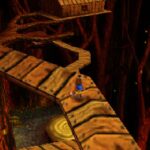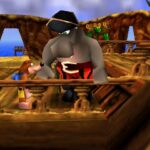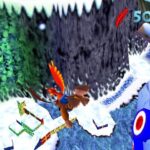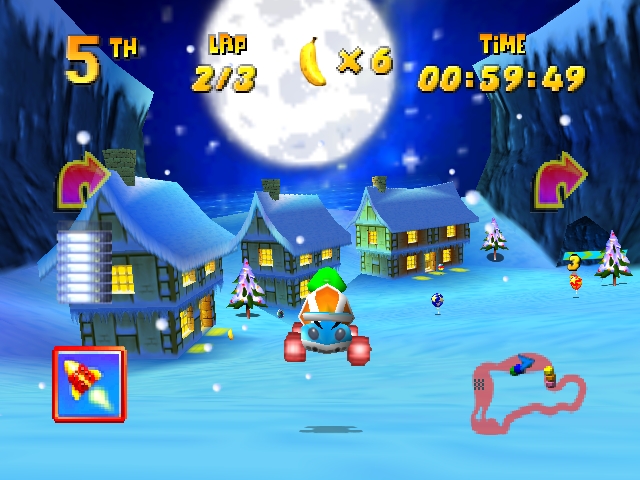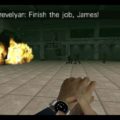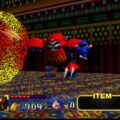Developer: Rare Publisher: Nintendo Released: June 29, 1998 Genre: Platformer
Super Mario 64 was a revolution within the game industry that we had not seen since the original Super Mario Brothers. It was not the first 3d platformer but it codified the way they were built, both technically and conceptually. Its success also meant that games built in its image would soon follow. Of the myriad number of Mario 64 clones Banjo Kazooie was one of the best that generation. Rare rarely (heh) missed that generation and not only built on Nintendo’s work but bettered it in some ways as well.
Although Banjo Kazooie is a great game it sure took its time and went through many revisions before release. Originally conceived as an action RPG for the SNES named Project Dream it starred a sword wielding human in a Disneyesque world. When it was moved to the N64 it radically changed into the game you see now. The proposed fall 1997 release would eventually turn into June 1998 unfortunately. While the wait was long it was worth it as there are few 3d platformers from that era with the variety Banjo Kazooie has.
The comparisons to Mario 64 are immediately obvious. Rather than coins Banjo collects jiggies (puzzle pieces) and coins are replaced with musical notes. Musical notes gate your progress throughout Gruntilda’s lair with new areas requiring a certain amount. There are other items to collect which I will get to later as well. Gruntilda’s Lair is the hub from which you will visit each of the game’s nine worlds. Accessing each level works differently. You must first find the painting representing each world and fill in the missing jiggies. Then you have to find it. This is one of the few complaints I have with the game. There are very few hints as to where each entrance is. In fact the paintings and entrances are often at completely opposite ends of the lair! It makes little sense and smacks of being different for the sake of it.
Although the similarities are undeniable Banjo Kazooie is still very much its own game. For one this is a team effort. Banjo and Kazooie have a number of moves they use in concert to get around each world. These range from movement related such as flying and spring jumping to item usage like invincibility feathers. The game does a great job of introducing new moves at a consistent clip that keeps gameplay fresh. Almost every button on the controller is used yet the controls remain intuitive. The only knock I have against the controls would be the camera. Like the game it mirrors the camera in Banjo Kazooie sometimes has a mind of its own and can be unresponsive. It will lead to many missed jumps that can be fatal later in the game. Unfortunately you have to live with it.
Banjo Kazooie is nonlinear in that you can collect jiggies in any order you wish. As you long as you can open each world you are free to explore. To an extent some parts are gated behind certain moves but it is amazingly open. The variety in how you obtain the various jiggies is the game’s greatest asset. Very few are out in the open and if they are require some effort to reach. Each world is bustling with activity with NPCs and large enemies that practically beg for interaction. Some jiggies are behind boss battles, others need specific moves to obtain. There are a large number of fun minigames to break up the platforming and some are legitimately challenging. There are 100 jiggies total but you don’t need all of them to reach the end. And best of all you aren’t kicked out of the world after collecting one.
Rare built somewhat of a reputation for collectathon bullshit during this era and you can see the beginnings of it here. Aside from jiggies and music notes every world has 5 jinjos needed for a puzzle piece. Mumbo tokens are used for a necessary transformation in every other world with the number required increasing every time. Red feathers enable flight, invincibility uses gold feathers and eggs are ammunition for Kazooie. The last three are not mandatory but you still need them all the same. Compared to Donkey Kong 64 Banjo Kazooie shows restraint but it only got worse from here on out.
Banjo Kazooie has a similar difficulty curve to its platforming brethren. The early jiggies are easy enough to get. Each world has one or two that can be obtuse to get but that is half the fun. By the midpoint however it starts to become more challenging and admittedly frustrating. The camera can be an issue when flying and using the beak bomb. The later areas such as Rusty Bucket Bay and Click Clock Woods amp up the difficulty with instant death floors, narrow ledges and steep drops. Click Clock Woods in particular is a design marvel but very frustrating. The final boss battle….well they certainly tried. I’ll leave it at that.
For its time Banjo Kazooie was one of the best looking games on the market. The game exhibits a level of texture detail that up until that point was unheard of on the system. The draw distance is incredible; you can climb to the highest point of each world and see nearly the entire map with no fog. The size of each map is also pretty large by that generation’s standards. Click Clock Wood is gargantuan in size and Rare made it four times over to match the seasons. And the game accomplishes all of this with a stable framerate. The soundtrack is also pretty great and varied. The music is dynamic and changes in real time per the situation which is an impressive feat. Every NPC has a distinct “voice” which, considering their number and that this is a cartridge game, is also amazing. Rare went all out.
In Closing
Banjo Kazooie is a fantastic game and one of the Nintendo 64’s best. Rare crafted a winner with varied gameplay, incredible graphics, and a meaty quest. Whether it’s the original N64 game or its various Xbox releases I urge all platformer fans to give this one a shot, you won’t regret it.


